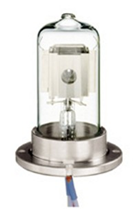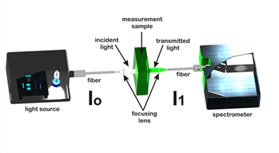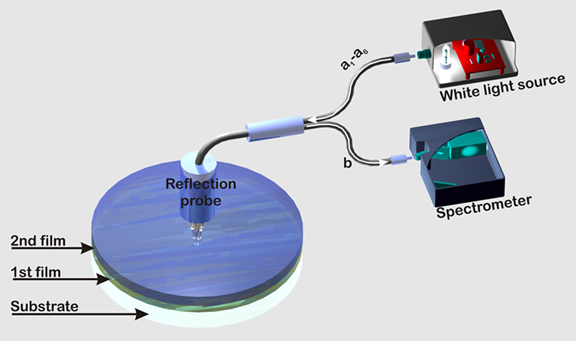|
Absorbance: is the ratio of the light intensity incident on the sample under investigation (Io) over the light intensity transmitted through the sample (I1). The absorbance is a unitless parameter, it is usually measured in logarithmic scale and depends on the wavelength. Therefore, A=-log10(Io/I1) or A=-log10{(I1-Id)/(Io/Id)} if we take into consideration the dark or baseline spectrum. When A=0.0 it means that I1=1.00*Io A=0.1 it means that I1=0.79*Io A=0.5 it means that I1=0.32*Io A=1.0 it means that I1=0.10*Io |
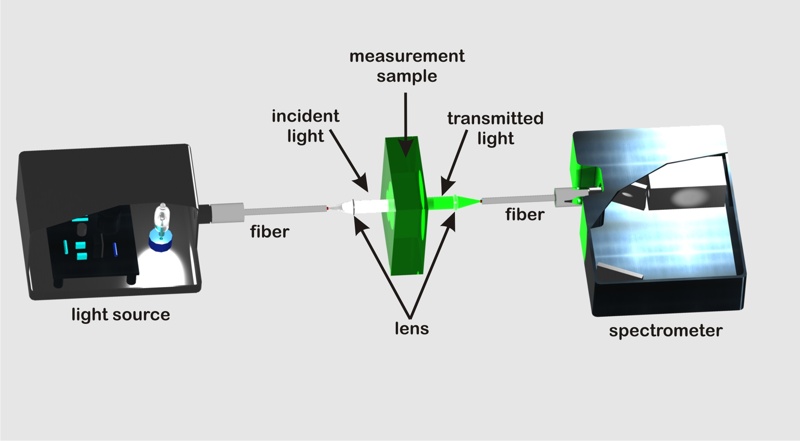 |
|||
|
A charge-coupled device (CCD) is a device for the movement of electrical charge, usually from within the device to an area where the charge can be manipulated, for example conversion into a digital value. This is achieved by "shifting" the signals between stages within the device one at a time. CCDs move charge between capacitive bins in the device, with the shift allowing for the transfer of charge between bins. The CCD is a major technology for digital imaging. In a CCD image sensor, pixels are represented by p-doped MOS capacitors. These capacitors are biased above the threshold for inversion when image acquisition begins, allowing the conversion of incoming photons into electron charges at the semiconductor-oxide interface; the CCD is then used to read out these charges. CCD along with the slit and the grating are the core components of the spectrometer. Further information can be found at: http://en.wikipedia.org/wiki/Charge-coupled_device |
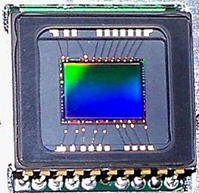 |
|||
|
Dark Spectrum is the reflectance spectrum when the light source is switched off, the ambient light infuence in the measuremet spectrum is recorded. The Dark Spectrum along with the Reference Spectrum are used for the measurement of the reflectance and the calculation of the film thickness(es) and properties of the sample under investigation. The fact that the Dark Spectrum is recorded it allows for operation at typical room condition, lights on. However, it is advised that direct illumination of the sample from room lights to be avoided |
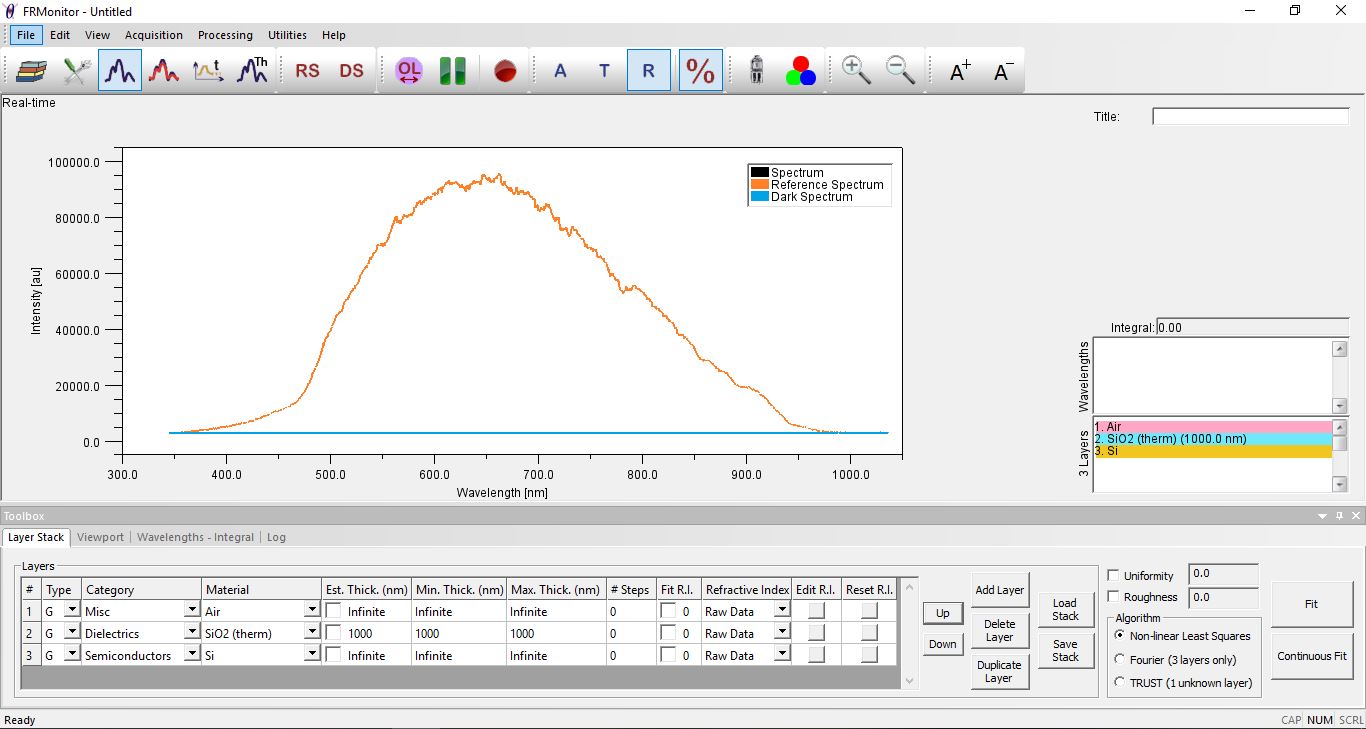 |
|||
|
deuterium lamp is a low-pressure gas-discharge light source. A deuterium lamp uses a tungsten filament and anode placed on opposite sides of a nickel box structure designed to produce the best output spectrum. Unlike an incandescent bulb, the filament is not the source of light in deuterium lamps. Instead an arc is created from the filament to the anode, a similar process to arc lamps. Because the lamp operates at high temperatures, normal glass housings cannot be used for a casing. They would also block UV radiation. Instead, a fused quartz, UV glass, or magnesium fluoride envelope is used depending on the specific function of the lamp.[2] The deuterium lamp emits radiation extending from 112 nm to 900 nm, although its continuous spectrum is only from 180 nm to 370 nm. Further information can be found at: http://en.wikipedia.org/wiki/Deuterium_arc_lamp |
|
|||
|
Ellipsometry measures the change of polarization, typically in reflection mode. The exact nature of the polarization change is determined by the sample's properties (thickness, complex refractive index or dielectric function tensor). Although optical techniques are inherently diffraction limited, ellipsometry exploits phase information and the polarization state of light, and can achieve sub-nm resolution. In its simplest form, the technique is applicable to thin films with thickness less than a nanometer to several micrometers. The sample must be composed of a small number of discrete, well-defined layers that are optically homogeneous and isotropic. Ellipsometry is an indirect method, i.e. in general the measured Ψ and Δ cannot be converted directly into the optical constants of the sample. Normally, a model analysis must be performed. Using an iterative procedure (least-squares minimization) unknown optical constants and/or thickness parameters are varied, and Ψ and Δ values are calculated using the Fresnel equations. The calculated and values which match the experimental data best provide the optical constants and thickness parameters of the sample. |
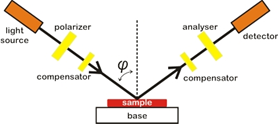 |
|||
|
grating is an optical component with a periodic structure, which splits and diffracts light into several beams travelling in different directions. The directions of these beams depend on the spacing of the grating and the wavelength of the light so that the grating acts as the dispersive element. Because of this, gratings are commonly used in monochromators and spectrometers. Thus, when light is normally incident on the grating, the diffracted light will have maxima at angles θm given by: d*sin(θm)=m*λFurther information can be found at: http://en.wikipedia.org/wiki/Diffraction_grating |
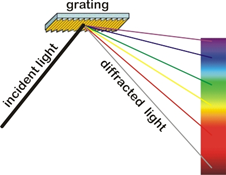 |
|||
|
monochromator is an optical device that transmits a mechanically selectable narrow band of wavelengths of light or other radiation chosen from a wider range of wavelengths available at the input. A monochromator can use either the phenomenon of optical dispersion in a prism, or that of diffraction using a diffraction grating, to spatially separate the colors of light. It usually has a mechanism for directing the selected color to an exit slit. Usually the grating or the prism is used in a reflective mode. A reflective prism is made by making a right triangle prism (typically, half of an equilateral prism) with one side mirrored. The light enters through the hypotenuse face and is reflected back through it, being refracted twice at the same surface. The total refraction, and the total dispersion, is the same as would occur if an equilateral prism were used in transmission mode Further information can be found at: http://en.wikipedia.org/wiki/Monochromator |
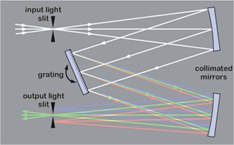 |
|||
|
A solar cell's quantum efficiency value indicates the amount of current that the cell will produce when irradiated by photons of a particular wavelength. If the cell's quantum efficiency is integrated over the whole solar electromagnetic spectrum, one can evaluate the amount of current that the cell will produce when exposed to sunlight. Two types of quantum efficiency of a solar cell are often considered: External Quantum Efficiency (EQE) is the ratio of the number of charge carriers collected by the solar cell to the number of photons of a given energy shining on the solar cell from outside (incident photons). Internal Quantum Efficiency (IQE) is the ratio of the number of charge carriers collected by the solar cell to the number of photons of a given energy that shine on the solar cell from outside and are absorbed by the cell.The IQE is always larger than the EQE. A low IQE indicates that the active layer of the solar cell is unable to make good use of the photons. To measure the IQE, one first measures the EQE of the solar device, then measures its transmission and reflection, and combines these data to infer the IQE. Further information can be found at: http://en.wikipedia.org/wiki/Quantum_efficiency |
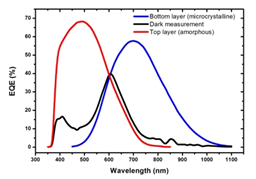 |
|||
|
Reference Spectrum is the reflectance spectrum from a sample with well-known reflectance properties. The Reference Spectrum is needed in order to eliminate the transfer function of the spectrometer, light source and optical fibers. Therefore. Reflectance s[ectrum shouldbe recorded at the same sampling conditions with the sample under investigation. Typical samples for recording the Reference Spectrum are Aluminum and Silicon |
 |
|||
|
Reflectance is the fraction of the incident optical power that is reflected at an interface and is also expressed as the square of the reflection coefficient. The reflectance is always a positive real number and is a function of the wavelength. In case of thin layers, the reflectance depends also on the thickness of the layer. When the film becomes very thick the reflectance reaches certain value which is called reflectivity. The reflectance can be specular and / or diffuse reflectance. Specular reflection is the mirror-like reflection of light from a surface. In specular reflection, the direction of incoming light, and the direction of outgoing light reflected make the same angle with respect to the surface normal. Typical specular surfaces are glass and polished metals. Diffuse reflection is the reflection of light from a surface such that an incident ray is reflected at many angles rather than at just one angle as in the case of specular reflection. An illuminated ideal diffuse reflecting surface will have equal luminance from all directions in the hemisphere surrounding the surface (Lambertian reflectance). In between the specular and Lambertian reflectance is the haze reflectance in which the incident light scattered about the specular direction. Typical diffuse surface is matte white paint. Further information can be found at: http://en.wikipedia.org/wiki/Reflectivity |
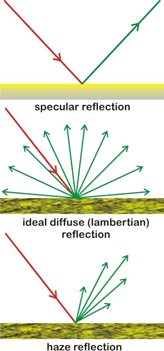 |
|||
|
Single Wavelength Interferometry (SWI) is an optical methodology for the monitoring of dynamic phenomena, (e.g. film swelling, film thickness loss), taking place during the processing of semi-transparent and transparent films. In SWI, the sample is placed on a leveled surface and the light beam from a quasi monochromatic light source incidents on the sample’s surface at a nearly 90o angle. The signal that recorded at the detector consist of the sum of the energy from the reflected beams, i.e. from the sample/air interface, the film/substrate interface, from the internal reflections in the transparent film. Any changes in the film properties causes change in the detector’s signal that is recorded in the PC through the data acquisition card. |
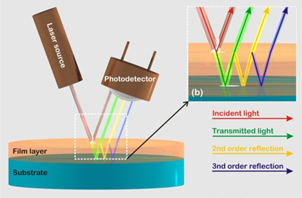 |
|||
|
A spectrometer is an instrument used to measure properties of light over a specific portion of the electromagnetic spectrum. Miniaturized spectrometers consist of a slit, a grating and a CCD array and are fully controlled by PCs. The spectral range the spectrometer can operate is defined by the CCD array and the grating. Most miniaturized spectrometers operate in the 350-1000nm by employing a Si CCD array |
||||
|
Transmittance is the fraction of incident light that passes through a sample. In equation form, T=I1/Io where Io is the intensity of the incident radiation and I1 is the intensity of the radiation coming out of the sample |
|
|||
|
A halogen lamp, is an incandescent lamp that has a small amount of a halogen such as iodine or bromine added. The combination of the halogen gas and the tungsten filament produces a halogen cycle chemical reaction which redeposits evaporated tungsten back on the filament, increasing its life and maintaining the clarity of the envelope. The halogen lamp produces a continuous spectrum of light, from near ultraviolet to deep into the infrared. Since the lamp filament can operate at a higher temperature than a non-halogen lamp, the spectrum is shifted toward blue, producing light with a higher effective color temperature. To reduce unintentional UV exposure, and to contain hot bulb fragments in the event of explosive bulb failure, general-purpose lamps usually have a UV-absorbing glass filter over or around the bulb. Further information can be found at: http://en.wikipedia.org/wiki/Halogen_lamp |
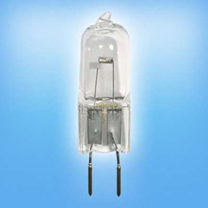 |
|||
| White Light Reflectance Spectroscopy (WLRS) resembles SWI but involves, instead of a laser (single wavelength), a VIS-NIR (or broader spectrum if needed) light source and a PC-driven miniaturized spectrometer, operating in the corresponding spectrum, instead of a photodetector. The light coming out from the light source is guided to a reflection probe guiding the white light onto the sample under investigation. The sample is illuminated vertically through a bunch of 6 fibers arranged in a circle and the reflected light is collected by the fiber located in the center of the circle and is guided to the spectrometer. The illumination fibers and the fiber collecting the reflectance light constitute the reflection probe. The typical sample under analysis consists of a stack of transparent and semi-transparent films over an appropriate reflective or transmitting substrate (e.g. Si wafer, microscope glass slide). The reflected light is continuously recorded and analyzed by the embedded spectrometer. The reflectance spectrum allows for the measurement of film thickness and optical properties of the films. |
|
|||
|
Color temperature is a characteristic of visible light that has important applications in lighting, photography, videography, publishing, manufacturing, astrophysics, horticulture, and other fields. The color temperature of a light source is the temperature of an ideal black body radiator that radiates light of comparable hue to that of the light source. In practice, color temperature is only meaningful for light sources that do in fact correspond somewhat closely to the radiation of some black body, like an incandescent lamp. Color temperatures over 5,000K are called cool colors (blueish white), while lower color temperatures (2,700–3,000 K) are called warm colors (yellowish white through red). Further information can be found at: http://en.wikipedia.org/wiki/Color_temperature |
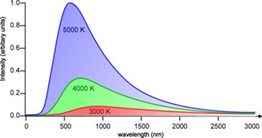 |

